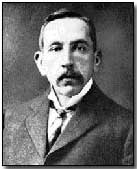Who's Who - Billy Hughes
 William Morris ('Billy') Hughes
(1862-1952) served as Australia's Prime Minister from 1915-23, a more
martial figure than his predecessor
Andrew Fisher
and with views on the prosecution of the war more in line with those of the
British Prime Minister
David Lloyd George.
William Morris ('Billy') Hughes
(1862-1952) served as Australia's Prime Minister from 1915-23, a more
martial figure than his predecessor
Andrew Fisher
and with views on the prosecution of the war more in line with those of the
British Prime Minister
David Lloyd George.
Hughes was born on 25 September 1862 in London to working class Welsh parents. Having qualified as a teacher he emigrated to Queensland where he worked variously (and suffering real poverty) as a stockman, factory hand, stone breaker, actor, ship's cook, railway fettler and bookseller before, in 1890, becoming an organiser for the Australian Workers Union.
Having established himself in union politics Hughes stood for and won a seat in the New South Wales Legislative Assembly in 1894. Although he opposed Federation he nevertheless chose to enter federal politics, becoming a founding member of the Commonwealth Labour Party under John Watson's leadership.
Hughes joined the first commonwealth parliament in 1901 and became Attorney General in 1910 in Fisher's ministry. In this role he helped to establish a national system of defence and judicial arbitration in labour disputes.
His vigorous determination to prosecute the war to the fullest made him the unanimous choice to succeed Fisher in October 1915 upon the latter's resignation as Prime Minister.
A charismatic man Hughes' manner of conducting domestic politics was equally vigorous, often bruising. His insistence upon calling two conscription referendums (October 1916 and November/December 1917 and which he both lost) split Labor and resulted in his ejection from the party, upon which he formed the Nationalist Party.
He nevertheless continued in office until 1923 at the head of two coalition governments, although he temporarily resigned in the wake of the second conscription referendum. He immediately returned to office once it became apparent that no-one else could take over.
Hughes travelled to Britain in January 1916 to argue for greater Australian involvement in determining the conduct of the war. His single-minded determination in pursuing victory at all costs endeared him to the highest levels of the British government. Indeed the very vigour of his approach led to accusations at home that he tailored his policy more to suit the British government than the Australian electorate.
Having engaged in discussions with Lloyd George, Hughes decided - without reference to his own cabinet at home - to purchase a fleet of 25 ships to form the basis of a government owned shipping line (subsequently sold off in the 1920s). He then toured Australian forces serving on the Western Front, earning himself the popular nickname "the little digger".
Hughes travelled to London again in April 1918 to attend the Imperial War Cabinet and was in London when the armistice was agreed. Successfully insisting upon a seat at the ensuing Paris Peace Conference Hughes was an imposing and (as ever) controversial figure whose white supremacist policies angered many (including U.S. President Wilson and the Japanese).
Re-elected in December 1919 Hughes immediately found himself in conflict with the Country Party over the following three years. His resignation was finally forced in 1923 and he returned to the backbenches, retaining his seat until his death in 1952. He remained politically active until the 1950s and succeeded in bringing about the resignation of Stanley Bruce in 1929.
He attempted to establish a new political force, the Australia Party, during the Depression of the 1930s, without notable success. He joined the United Australia Party in the 1930s and held numerous cabinet posts under the administrations of Joseph Lyons and Sir Robert Menzies, the former of whom he criticised for not preparing sufficiently for war with Germany. Hughes became leader of the United Australia Party in 1941 and worked with the Labor Party from 1941-45 on the Advisory War Council.
Hughes married in 1886, to Elizabeth Cutts; they had six children before she died in 1906. He married again to Mary Campbell in 1911; she was subsequently made a Dame Grand Cross of the British Empire in 1922 for her services during the First World War.
After a half century in active politics Billy Hughes died on 28 October 1952 in Sydney aged 90. He published two sets of memoirs: Crusts and Crusades (1947) and Policies and Potentates (1950).
An Armlet was a cloth band worn around the arm to identify a particular duty or function.
- Did you know?
